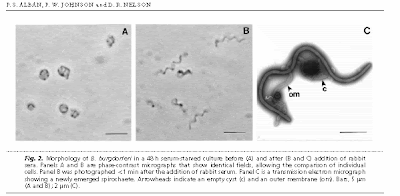
Lyme l-form to spirochete morph from: http://www.actionlyme.org/BOGUS_4.gif
BACTERIAL ANTIBIOTIC RESISTANCE GENES DISCOVERED
By Aleena Lakhanpal - 5 November 09 -Quoted direct from http://media.www.jhunewsletter.com/media/storage/paper932/news/2009/11/05/ScienceTech/Bacterial.Antibiotic.Resistance.Genes.Discovered-3824803.shtml
Antibacterial soap, hand sanitizer and antibiotics are all substances that we use in an attempt to kill bacteria that might make us sick. Whether we are concerned about getting strep throat, bacterial meningitis or something else, these prevention methods can offer protection.
However, some bacteria, such as those that cause Staph and MRSA infections, are becoming increasingly resistant to antibiotics. Since the 1930s, researchers have been aware that bacteria may be able to resist treatment because they can morph into the L-form, or bacteria lacking cell walls.
Until the 1980s, not much else could be known about the L-form, but now, researchers at the Bloomberg School of Public Health have used a wide variety of modern molecular tools to learn more about the origin and biological functions of the L-form bacteria.
Ying Zhang, a professor of molecular microbiology and immunology at Bloomberg, is the senior author of the study, which was published in PLoS ONE last month.
Not all bacteria can transform into the L-form, but those that can include Bacillus anthracis (anthrax), Treponema pallidum (syphilis), Mycobacterium tuberculosis (tuberculosis), Heliobacter pylori (stomach ulcers and cancer), Borrelia burgdorferi (Lyme disease) and Escherichia coli (food poisoning). Zhang's team used E. coli to create a culture of L-form bacteria.
Although it had been difficult to culture L-form bacteria before, Zhang and his team created a new method that more closely simulated the in vivo conditions in which these bacteria form.
"The presence of antibiotic stress is cell wall inhibiting, like penicillin," Zhang said. To prevent the cells from bursting because of this increased stress, Zhang's team added sucrose to the cell media.
This culture represented the mechanism that occurs in the body. "L forms are formed in response to stress," Zhang said. "They have a different mode of survival and replication from classical bacteria." The cell wall-deficient bacteria cluster together in the shape of a fried egg rather than the smooth, homogeneous appearance of wild-type bacteria cultures.
Not only are L-form bacteria difficult to culture and therefore study, but this "fried egg" cluster is part of what makes the L-form bacteria resistant to antibiotics, in addition to the fact that they do not have cell walls for commonly used antibiotics to disintegrate.
Once Zhang and his team were able to successfully culture L-form E. coli, they screened for and identified mutants that fail to grow at the L-form. From these mutants, they were able to discover a series of genes that were linked with the inability to grow in the L-form.
"These fall into four to five different categories involving extracellular matrix synthesis, membrane proteins, membrane biogenesis, DNA repair as well as iron metabolism and energy metabolism," Zhang said.
Their identification of these genes and their effect on L-form bacterial expression is a resounding discovery because it was impossible to do before, what with the difficulty of culturing the L-forms of various bacteria. Zhang noted, however, that although his team managed to create and study a culture of L-form bacteria, their study cannot be universal.
"What we can culture is only a small percentage - probably less than 1 percent - of all bacteria on earth," Zhang said.
"They exist in nature and grow easily, but we're limited to what we can grow and the form of bacteria that can grow. Bacteria can grow a variety of different forms even for the same species, and can change forms under different conditions. L-forms are one example of changing under antibiotic stress."
These L-forms of various bacteria may be the underlying reason for chronic resistant and recurring diseases, such as sarcoidosis, various forms of inflammatory bowel diseases and rheumatoid arthritis. Zhang is confident that there will be many practical applications of this discovery.
"It is possible, with our discovery of the L-form genes to develop new antibiotics and more effective ones that can be used with current ones as well as new vaccines to . . . allow these forms to be eliminated by the immune system," he said."



No comments:
Post a Comment